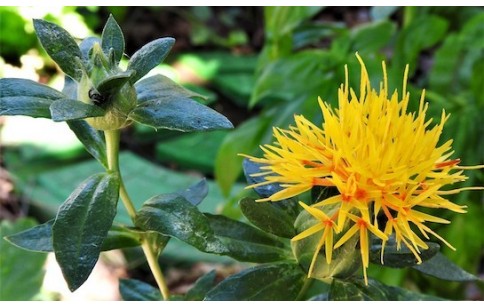- Code : #1027 S 20 mg
- Formula : C₂₁H₂₀O₁₂
- CAS : 482-36-0
Carthamus tinctorius
Carthamus tinctorius, “Safflower” in English and “Carthame des teinturiers” in French, belongs to the Asteraceae botanical family. It is a herb that grows to 1 m or more.
Probably native to Southern Asia, it has been cultivated in China, India, Iran and Egypt almost from prehistoric times. It grows in poor dry soils in full sun.
The plant is cultivated mainly for its seeds edible oil. Its petals yield a red dye and an edible yellow dye used as a saffron substitute.
It has been used in traditional medicines as an antidote to poison, for the treatment of menstrual pains, post-partum hemorrhage, whooping cough, chronic bronchitis, rheumatism, sciatica, osteoporosis etc. Research has shown its antioxidant, analgesic, anti-inflammatory and antidiabetic activities.
The flowers main constituents are carthamidin, isocarthamidin, hydroxysafflor yellow A, safflor yellow A, safflamin C and luteolin-7-glucoside, quercetin-3-glucoside and quercetin-7-glucoside.

- Code : #1243 S 10 mg
- Formula : C₂₁H₂₀O₁₁
- CAS : 480-10-4
- Code : #1053 S 10 mg
- Formula : C₂₇H₃₀O₁₅
- CAS : 17650-84-9
- Code : #1126 S 20 mg
- Formula : C₂₁H₂₀O₁₁
- CAS : 5373-11-5
- Code : #1135 S 20 mg
- Formula : C₁₅H₁₀O₇,2H₂O
- CAS : 6151-25-3
- Code : #1327 S 20 mg
- Formula : C₂₁H₂₀O₁₂
- CAS : 482-35-9
- Code : #1380 S 10 mg
- Formula : C₂₁H₂₀O₁₂
- CAS : 491-50-9
- Code : #1139 S 50 mg
- Formula : C₂₇H₃₀O₁₆
- CAS : 153-18-4









